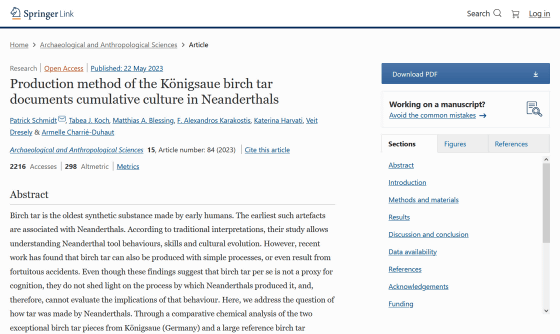Possibility that Neanderthals made ``ancient glue'' in a complicated process, evidence that they had high cognitive ability and culture

Production method of the Königsaue birch tar documents cumulative culture in Neanderthals | SpringerLink
https://doi.org/10.1007/s12520-023-01789-2

Neanderthals May Have Been The First To Carefully Concoct This Substance : ScienceAlert
https://www.sciencealert.com/neanderthals-may-have-been-the-first-to-carefully-concoct-this-substance
Birchtal is a substance widely used as an adhesive from the Middle Paleolithic to the early Mesolithic , and is the oldest synthetic material made by early humans. Birchtal can be extracted by burning birch bark, and the earliest birchtal has been found in Neanderthal sites, providing evidence for Neanderthal cognitive abilities and cultural evolution.
However, recent research has revealed that birch tar can be obtained simply by scraping off the residue that adheres to the surrounding rock surface when burning birch bark as fuel for bonfires. Therefore, it is also possible that Neanderthals acquired birch tals simply by a 'happy accident'.

In order to verify whether Neanderthal production of birchtal was 'intention' or 'accidental', research teams such as
The two birch tars stored in the Halle State Prehistoric Museum are believed to have been made between 45,000 and 80,000 years ago, but the exact age has not been specified. Since one sample was found in a layer below the other sample, it is possible that there is a considerable time difference between the times when the two birch tars were made.

As a result of chemically analyzing birch tar, it was found that all birch tars were deprived of oxygen during the process of making them. Therefore, the research team experimented on the `` manufacturing method of birch tar '' that has been considered so far, and investigated what kind of chemical composition the birch tar made by each manufacturing method has. Of the manufacturing methods 'b' to 'f' shown in the images below, 'b' and 'c' are made by burning birch bark on the ground, and 'd' to 'f' are buried in the ground. It is a method of making by heating the bark with embers or bonfires.

Analysis of the sample produced in the experiment revealed that the chemical composition was similar to the birch tar found in the ruins of Konigsaue, and that it was a sample of birch bark burned underground from 'd' to 'f'. got it.
The process of burying birch bark underground and heating it is unlikely to happen by chance, and you must dig up the buried bark to obtain birch tar. Therefore, the results of this study suggested that ``Neanderthals did not get birch tal by chance as a result of bonfires, but used a carefully planned and complicated process to manufacture birch tal.'' It was.
The research team points out that the 'recipe' that Neanderthals made birch tal may have been invented through trial and error and improved over time. 'We show for the first time that Neanderthals likely invented and improved transformative technologies independently of Homo sapiens influence,' he said.

by Sue Ruth
Related Posts:
in Science, Posted by log1h_ik







